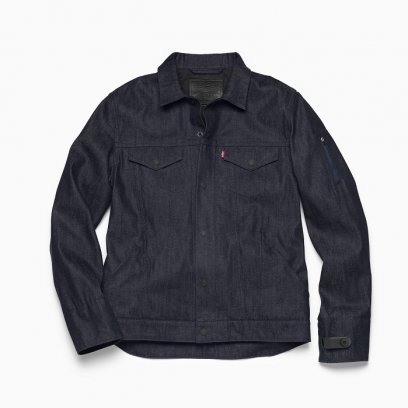
Levi’s jacket with Jacquard by Google debuts
At Google’s developer conference, the two iconic San Francisco companies revealed the first garment that was created through Project Jacquard.

27th May 2016
Innovation in Textiles
|
San Francisco, US
Google and Levi’s have revealed the first garment that was created through Project Jacquard, a partnership to develop interactive denim woven with conductive fibres.
At Google’s developer conference, the two iconic San Francisco companies shared the Levi’s Commuter Trucker Jacket, designed for the urban cyclist as a result of a year-long effort between the Levi’s Innovation team and Google’s Advanced Technology and Projects (ATAP) group.
The Levi's innovation team and Google teams joined forces aiming to create a modern version of denim that is interactive and yet authentic, remaining true to the century-old tradition of denim manufacturing.
During last year’s Google I/O conference, the Levi’s brand became Google ATAP’s first partner on Project Jacquard, which credited the brand for being authentic, innovative and fashionable. Jacquard allows wearers to control their mobile experience and connect to a variety of services, such as music or maps, directly from the jacket. This is especially useful when it might be difficult to use the smart phone, for example, when riding a bike.
“Anyone on a bike knows that navigating your screen while navigating busy city streets isn’t easy – or a particularly good idea. This jacket helps to resolve that real-world challenge by becoming the co-pilot for your life, on and off your bike,” said Paul Dillinger, head of global product innovation for Levi Strauss & Co.
Project Jacquard makes it possible to weave touch and gesture interactivity into any textile using standard, industrial looms. Everyday objects, such as clothes and furniture, can be transformed into interactive surfaces. This is possible thanks to new conductive yarns, created in collaboration with Google’s industrial partners.
Jacquard yarn structures combine thin, metallic alloys with natural and synthetic yarns like cotton, polyester, or silk, making the yarn strong enough to be woven on any industrial loom. Using conductive yarns, bespoke touch and gesture-sensitive areas can be woven at precise locations, anywhere on the textile. Alternatively, sensor grids can be woven throughout the textile, creating large, interactive surfaces.
The complementary components are engineered to be as discreet as possible. We developed innovative techniques to attach the conductive yarns to connectors and tiny circuits, no larger than the button on a jacket. These miniaturized electronics capture touch interactions, and various gestures can be inferred using machine-learning algorithms. Captured touch and gesture data is wirelessly transmitted to mobile phones or other devices to control a wide range of functions, connecting the user to online services, apps, or phone features.

Business intelligence for the fibre, textiles and apparel industries: technologies, innovations, markets, investments, trade policy, sourcing, strategy...
Find out more